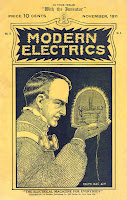
Twenty years ago, while browsing a catalog of the State Street Bookshop in Ann Arbor, Michigan I came across an the first issue of an interesting magazine called The Yellow Kid. As it turned out, it was part of a huge collection of first issue magazines bought by the proprietor, Kevin Sheets. My 85 dollar purchase was pretty good, even for the time and, by virtue of it, I eventually went out to Ann Arbor and bought the whole shebang for $20.000. It was a seminal moment in my life since it represented the beginning of my serious pursuit of first issue magazines. Hundreds of thousands of dollars and probably tens of thousands of hours later I'm still at it and it has been one of the most consistently pleasurable pastimes I've enjoyed. The State Street collection had many items I've never seen again and many rare ones (the first National Geographic, for example) which I continue to prize.
I didn't know the history of the "kid" when I bought it, but it really is a milestone in American publishing history. The magazine had this name for only nine issues then became Yellow Book (just bought a copy, in wrappers for twenty dollars that brought about this blog entry) and then Ainslees's, which lasted into the twenties as an illustrated fiction monthly.
I can add very little to Dr. Richard D. Olsen's great web site www.neponset.com/yellowkid/history.htm about the history of the Yellow Kid and his importance.
Basically, Outcault first drew him for the June, 2, 1894 issue of the widely circulated then but now quite obscure magazine called Truth, soon republished in Joseph Pulitzer's newspaper, The New York World. He became so immensely popular that the other giant of New York publishing, William Randolph Hearst, in a way reminiscent of the present day New York Yankees, bought him away from Pulitzer for his New York Journal. Not to be outdone, Pulitzer hired George B. Luks to continue to draw the Kid for him and the two competing papers became known as the "Yellow Kid papers".
the first apperance in Truth
Despite the fact that today's prestigious journalism award is named after him, Pulitzer and Hearst did not necessarily feel that the truth should get in the way of selling newspapers. Their competition, using often factitious and highly exaggerated reporting became a matter of criticism by more ethical (and less profitable) journalists. Because both papers featured the Kid, "yellow journalism" came into the lexicon, still meaning exaggerated, unscrupulous publishing.
Aside from this, The Yellow Kid is considered to be the first successful comic strip character, a genre still widely popular today. Interestingly, the magazine does not have the kid inside it at all, just the cover illustration and his name.
A very rare contemporary magazine called Vim picked up on the war between Hearst and Pulitzer. Here is an illustration of of one of them from my collection (with the Kid as Hearst).
After the Kid craze calmed down, Outcault went on to father another widely recognized comic character, Buster Browm. As with the Kid, Buster Brown was used to sell wide variety of products- most notably socks and shoes (remember the Andy's Gang TV show of the fifties?). A very rare advertising vehicle The Buster Brown Stocking Magazine, lasted only a few issues. I have found and bought three of them over the years. Here is the first issue, January 1906- despite the price probably given away rather than sold


A copy of this magazine sold at a Hakes auction in 2007 for $320. The first issue of the Yellow Kid would probably sell for a few thousand.
Hope you enjoyed today's lesson in etymology as well as gaining further appreciation of the importance of the American periodical.
Happy New Year to all!!

















































